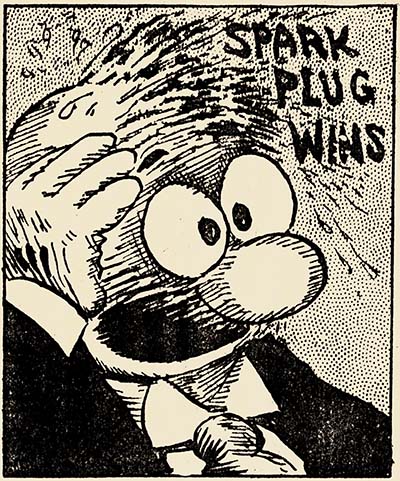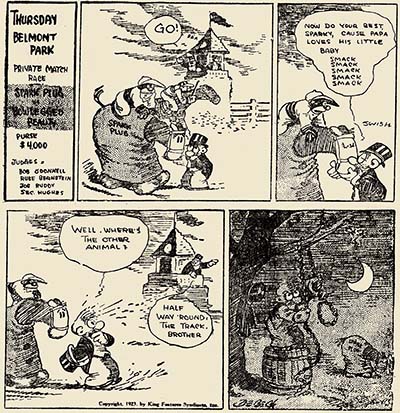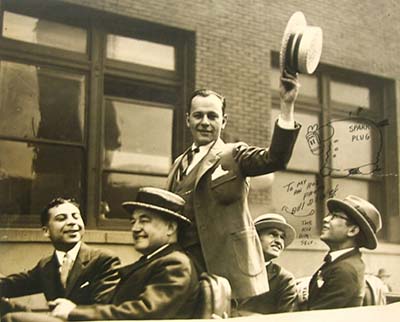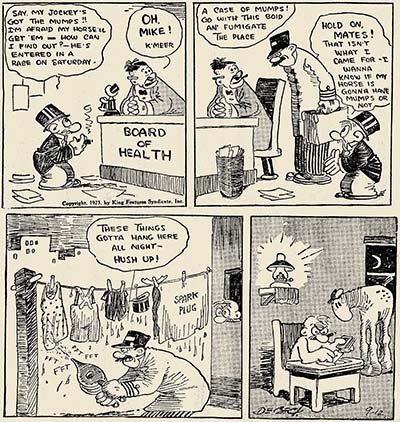Every other month, members of Animation Resources are given access to an exclusive Members Only Reference Pack. In July 2015, they were able to download this collection of classic daily newspaper strips by Billy DeBeck. Our Reference Packs change every two months, so if you weren’t a member back then, you missed out on it. But you can still buy a copy of this great e-book in our E-Book and Video Store. Our downloadable PDF files are packed with high resolution images on a variety of educational subjects, and we also offer rare animated cartoons from the collection of Animation Resources as downloadable DVD quality video files. If you aren’t a member yet, please consider JOINING ANIMATION RESOURCES. It’s well worth it.
Billy DeBeck’s Barney Google![]()
Daily Strips – May 7th to October 5th, 1923
William Morgan DeBeck (April 15, 1890 – November 11, 1942), better known as Billy DeBeck, was an American cartoonist. He is most famous as the creator of the comic strip Barney Google (later retitled Barney Google and Snuffy Smith). The strip was especially popular in the 1920s and 1930s, and featured a number of well-known characters, including the title character, Bunky, Snuffy Smith and Spark Plug the race horse. Spark Plug was a merchandising phenomenon, and has been called the Snoopy of the 1920s.
DeBeck drew with a scratchy line, and his characters had giant feet and bulbous noses—what is traditionally called a “big-foot” style. His strips often reflected his love of sports. The first awards of the National Cartoonists Society, beginning in 1946, were the Billy DeBeck Memorial Awards (or the Barney Awards).
Animation Resources is proud to present an uninterrupted run of Barney Google daily strips from 1923 as a downloadable high resolution e-book. This PDF e-book is optimized for display on the iPad or printing two up with a cover on 8 1/2 by 11 inch paper.
REFPACK005: Billy DeBeck’s Barney Google![]()
Adobe PDF File / 113 Pages
311 MB Download
A sampling of some of the material in the e-book…
Billy DeBeck Biography
PERSONAL HISTORY
Billy DeBeck was born and grew up on the south side of Chicago, where his father, Louis DeBeck, was a former newspaperman employed by the Swift Company. His father was French, and the name DeBeck evolved from DeBecque. His Irish-Welsh mother, Jessie Lee Morgan, had lived on a farm and was a former schoolteacher.
EARLY CAREER
DeBeck attended Hyde Park High School, after which he went to the Chicago Academy of Fine Arts. During this time, he sold cartoons to finance himself, starting in 1908 at the Chicago Daily News. Though he had intended to become a painter in the Flemish tradition, he gave it up after he landed a cartooning job with the weekly paper Show World in 1910. His cartoons showed the influence of John T. McCutcheon and Clare Briggs, whom he had admired in his youth, although he had the skill to draw in the more fastidiously cross-hatched style of a Charles Dana Gibson, and had sold drawings as originals that he had copied from Gibson.
He soon left Show World for better opportunities at Youngstown Telegram in Ohio as a political cartoonist, then again at the Pittsburgh Gazette-Time in late August 1912, and later again he began doing cartoons for the New York City magazines Life and Judge. While in Pittsburgh, he went to a Hearst newspaper in New York and showed comic strip samples to Arthur Brisbane, who rejected the work. DeBeck later admitted, “They were terrible. I had been doing political cartoons for the Pittsburgh Gazette, and the comics were new to me”. He returned to Youngstown and married Marian Louise Shields there in 1914. Some time later they divorced, remarried in 1921, and eventually divorced again.
In May 1915, he and a partner, Carter, launched a newspaper syndicate and correspondence cartooning course. When that did not pan out, DeBeck returned to Chicago and joined the Chicago Herald in December 1915. He worked on a strip called Finn an’ Haddie for the Adams Newspaper Service on the side. On 9 December, immediately after starting at the Herald, he began a strip called Married Life that so caught the attention of newspaper magnate William Randolph Hearst that legend says he bought the Herald (merging it with the Chicago Examiner) in order to get his hands on DeBeck, who had refused to join the Hearst empire after the Examiner raised his monthly salary from $35 to $200. He created a number of other features, especially for the sports section, while his antics made him something of a local celebrity.
BARNEY GOOGLE
On July 17, 1919, DeBeck created a new comic strip on the sports page in the same vein as Married Life. Take Barney Google, For Instance differed in that it was about a henpecked, sports-obsessed husband and his travails defying the opposition of his wife. He was interested in non-fictional sports stories, such as the current heavyweight championship between Jess Willard and Jack Dempsey. The title was soon shortened to Barney Google, but the strip was not terribly popular until DeBeck had Google acquire a race horse named Spark Plug (or “Sparky”) in a strip dated July 17, 1922. The dilapidated, blanket-covered horse was a huge hit with readers, a marketing and merchandising phenomenon that has been called the Snoopy of the 1920s—toys, balloons and games were among the popular items adorned with Sparky’s image. When DeBeck introduced the horse, he also introduced a little-used technique into the strip- continuity.
Barney Google went from being a gag-a-day strip to one in which both humor and suspense kept readers coming back every day, as Google desperately tried to get his horse to win a race. The sequence in which Spark Plug was introduced into the strip was republished in the October 1922 issue of Comic Monthly, what is likely the earliest newsstand comics periodical. Barney had been as tall as his wife when the strip began, but by the early 1920s, DeBeck had made him quite short.
DeBeck kept readers on the edge of their seats with his uncertain suspense- sometimes Spark Plug actually won a race. In 1923, Billy Rose penned a smash pop hit called Barney Google with the catchy refrain: “Barney Google, with the goo-goo-gooly eyes”. While DeBeck initially resisted, Hearst demanded a pretty girl be introduced into the strip. DeBeck brought in Sweet Mama, which initially created a stir, with papers dropping the strip, but after the phrase swept the nation, the strip’s popularity only increased. Over the years, DeBeck was credited with introducing more neologisms and catchphrases, such as “heebie-jeebies”, “horsefeathers”, “hotsy totsy”, “osky wow wow”, “bughouse fables”, “balls of fire” and “time’s a-wastin'”.
DeBeck had included a topper called Bughouse Fables (signed “Barney Google”) with his main strip since 1921, though he soon handed off to assistant Paul Fung. On May 16, 1926, he replaced Bughouse Fables with Parlor, Bedroom & Sink Starring Bunky, a strip that was popular enough on its own to survive until 1948.
According to later Barney Google and Snuffy Smith scripter Brian Walker, DeBeck had become “one of the highest-paid cartoonists in America” at this point. In the early 1920s, DeBeck moved to Riverside Drive in New York City, and in 1927 he would remarry to Mary Louise Dunne. He and his new wife spent the next two years in Europe, after which they settled down again in New York. DeBeck’s active lifestyle sometimes caused him to miss deadlines. He enjoyed traveling, deep sea fishing, golf and playing bridge. As a golfer since 1916, DeBeck spent time on courses with such notables as Harold Lloyd, Walter Huston, Rube Goldberg, Fontaine Fox, Clarence Budington Kelland and bridge authority P. Hal Sims. He was also acquainted with such celebrities as Babe Ruth, Lowell Thomas and Damon Runyon. His best friend was the cartoonist Frank Willard, who also attended the Chicago Academy of Fine Arts.
SNUFFY SMITH
In the spring of 1934, DeBeck hired 17-year-old Fred Lasswell as an assistant after seeing his work on a poster. He wanted a letterer for Barney Google, and Lasswell’s lettering impressed him. Lasswell started by doing chores for DeBeck, as well as taking on lettering and other duties on the strip. DeBeck undertook educating Lasswell in cartooning, having him attend schools, copy the works of masters like Gibson and May, and copy line-for-line the artwork from DeBeck’s own comics. Lasswell moved in with the DeBecks, and would tag along with them wherever they moved. He would take over his mentor’s strip after his death and continue it into the 21st century.
DeBeck gained a growing interest into the culture of Appalachia in the 1930s and amassed a library on the subject that he would later donate to Virginia Commonwealth University. The character Snuffy Smith grew from his talking with and sketching the Appalachian hillbilly locals. Just as the strip’s circulation was starting to flag, Snuffy was introduced in a storyline in which Barney had inherited an estate in the mountains of North Carolina. After dodging the ornery hillbilly’s bullets, the two became fast friends. The strip would eventually be renamed Barney Google and Snuffy Smith, and Snuffy would take over from Barney Google as the central character. Lasswell, with his own country roots, provided much of the inspriration for Snuffy and his Appalachian environment. Especially, he provided a source for the locals’ dialect.
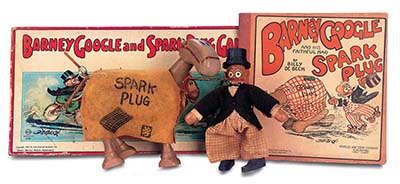
LATER LIFE AND DEATH
DeBeck had a studio apartment on Park Avenue in New York, and homes in Great Neck, Long Island and St. Petersburg, Florida. In the early 1940s, he developed cancer, and found it increasingly difficult to work. Sensing the end was near, he made a special trip to see Marian Shields. His last signed daily strip appeared 4 July 1942, and his last Sunday the following 2 August. With Lasswell contributing to the war effort, the strip was continued by assistant Joe Musial. On 11 November 1942, DeBeck died at the age of 52 in New York City, with his wife at his bedside. He had no children. Barney Google was continued by Musial until Lasswell took it on full-time in 1945. Eventually Barney faded from the strip, and the title shrank to Snuffy Smith.
In 1943, Mary DeBeck donated to the Ringling School of Art all of her late husband’s art supplies, including drawing tables, reams of drawing paper, hundreds of colored pencils, lamps, drawing boards, inks, drawing pens, artist smocks, etching plates and an etching press. Mary remarried, and she died 14 February 1953, aboard a National Airlines DC-6 which went down in the Gulf of Mexico during a thunderstorm on a flight from Tampa, Florida to New Orleans.
STYLE AND LEGACY
DeBeck’s art had a scratchy line, and drew characters with bulbous noses and giant feet in the “big-foot” tradition of American comic strips such as The Katzenjammer Kids and Hagar the Horrible. The influence continues to be felt in the work of cartoonists like Bobby London and Ralph Bakshi who have both expressed great admiration for DeBeck’s pioneering work.
Legacy
DeBeck’s main strip, in the hands of Fred Lasswell, continued long after its creator’s death. In 1989, the strip was still running in 900 newspapers in 21 countries, and it continues to this day in different hands since Lasswell’s 2001 death. Charles M. Schulz, creator of the Peanuts comic strip, is famously nicknamed “Sparky” after DeBeck’s racehorse character. The Barney Google Sunday page for September 18, 1938 was placed in the time capsule at the 1939 World’s Fair.
The National Cartoonists Society’s annual award was originally named the Billy DeBeck Memorial Award. Created by Mary DeBeck Bergman in 1946, these were known as the Barney Awards. She also made the annual presentation of engraved silver cigarette cases, with DeBeck’s characters etched on the cover, to the winners (Milton Caniff, Al Capp, Chic Young, Alex Raymond, Roy Crane, Walt Kelly, Hank Ketcham and Mort Walker). In 1954, after her death, the DeBeck Award was renamed the Reuben Award (after Rube Goldberg’s first name), and all of the prior winners were given Reuben statuettes. (Source: Wikipedia.org)
Not A Member Yet? Want A Free Sample?
Check out this SAMPLE REFERENCE PACK! It will give you a taste of what Animation Resources members get to download every other month!
JOIN TODAY To Access Members Only Content














